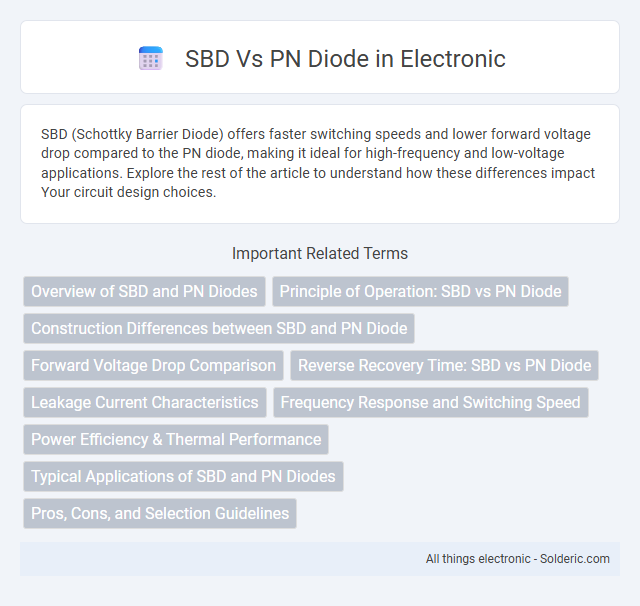SBD (Schottky Barrier Diode) offers faster switching speeds and lower forward voltage drop compared to the PN diode, making it ideal for high-frequency and low-voltage applications. Explore the rest of the article to understand how these differences impact Your circuit design choices.
Comparison Table
| Feature | SBD (Schottky Barrier Diode) | PN Diode |
|---|---|---|
| Construction | Metal-semiconductor junction | PN semiconductor junction |
| Forward Voltage Drop | 0.2 - 0.3 V | 0.6 - 0.7 V |
| Reverse Recovery Time | Very fast (nanoseconds) | Slower (microseconds to milliseconds) |
| Reverse Leakage Current | Higher leakage current | Lower leakage current |
| Switching Speed | High-speed switching | Slower compared to SBD |
| Applications | Power rectifiers, RF detectors, clamping diodes | General rectification, signal demodulation |
| Temperature Sensitivity | More sensitive to temperature | Less sensitive to temperature |
Overview of SBD and PN Diodes
Schottky Barrier Diodes (SBD) feature a metal-semiconductor junction that enables ultra-fast switching and low forward voltage drop, making them ideal for high-frequency and power-efficient applications. PN diodes consist of a p-type and n-type semiconductor junction, offering higher reverse breakdown voltage but slower switching speeds compared to SBDs. The distinct structural differences result in varying electrical characteristics suitable for specific roles in rectification, voltage clamping, and signal demodulation.
Principle of Operation: SBD vs PN Diode
Schottky Barrier Diodes (SBD) operate based on the metal-semiconductor junction, allowing majority carriers to flow with minimal barrier, resulting in fast switching and low forward voltage drop. In contrast, PN diodes function through a p-n junction where current conduction involves both majority and minority carriers, causing slower switching and higher forward voltage. The distinct carrier mechanisms in SBDs lead to reduced charge storage and faster recovery times compared to the recombination processes dominating in PN diodes.
Construction Differences between SBD and PN Diode
Schottky Barrier Diodes (SBD) feature a metal-semiconductor junction, typically aluminum or platinum in contact with n-type silicon, which results in a lower forward voltage drop and faster switching speed. In contrast, PN diodes consist of a p-type and n-type semiconductor junction formed by doping silicon with acceptor and donor impurities, leading to higher forward voltage and slower response. Understanding these construction differences helps you select the appropriate diode for high-speed switching or low forward voltage applications.
Forward Voltage Drop Comparison
SBD (Schottky Barrier Diode) typically exhibits a lower forward voltage drop ranging from 0.15 to 0.45 volts compared to PN diodes which generally have a forward voltage drop between 0.6 to 1.0 volts. This reduced forward voltage drop in SBDs results in higher efficiency and lower power loss in high-frequency and low-voltage applications. The lower voltage drop of SBDs is due to the metal-semiconductor junction, unlike the PN junction in standard diodes that requires overcoming a larger potential barrier.
Reverse Recovery Time: SBD vs PN Diode
Schottky Barrier Diodes (SBD) exhibit significantly lower reverse recovery time compared to PN diodes, typically in the nanosecond range versus microseconds for PN diodes. This rapid switching capability of SBDs reduces switching losses and electromagnetic interference in high-frequency applications. Consequently, SBDs are preferred in power conversion and high-speed rectification where efficiency and fast recovery are critical.
Leakage Current Characteristics
Schottky Barrier Diodes (SBD) exhibit significantly lower leakage current compared to PN diodes due to their metal-semiconductor junction, which reduces minority carrier injection. PN diodes typically have higher leakage currents because of recombination and generation currents within the depletion region under reverse bias. Low leakage current in SBDs enhances their efficiency in high-frequency and low-voltage applications, making them ideal for power rectification and switching circuits.
Frequency Response and Switching Speed
SBD (Schottky Barrier Diode) exhibits superior frequency response and switching speed compared to PN diodes due to its majority carrier conduction mechanism, resulting in minimal charge storage and faster recovery times. The lower forward voltage drop and negligible reverse recovery time of SBDs make them ideal for high-frequency applications such as RF circuits and switching power supplies. In contrast, PN diodes have slower switching speeds caused by minority carrier recombination, limiting their performance in high-speed switching environments.
Power Efficiency & Thermal Performance
Schottky Barrier Diodes (SBD) offer superior power efficiency compared to PN diodes due to their low forward voltage drop, which reduces conduction losses in high-frequency and low-voltage applications. The thermal performance of SBDs is enhanced by lower heat generation and better handling of reverse recovery, allowing for more effective heat dissipation and improved reliability in power-sensitive designs. Your choice of diode directly impacts overall system efficiency and thermal management, making SBDs preferable where minimizing power loss and heat buildup is critical.
Typical Applications of SBD and PN Diodes
Schottky Barrier Diodes (SBD) are typically used in high-speed switching circuits, power rectification, and low-voltage applications due to their fast recovery time and low forward voltage drop. PN diodes are commonly found in general-purpose rectification, voltage regulation, and signal demodulation across various electronic devices. SBDs excel in switching power supplies and RF applications, while PN diodes remain essential in standard power supply and protection circuits.
Pros, Cons, and Selection Guidelines
Schottky Barrier Diodes (SBD) offer low forward voltage drop and fast switching speeds, making them ideal for high-frequency and low-voltage applications, while standard PN diodes provide higher reverse voltage tolerance and better thermal stability. The main drawbacks of SBDs include higher leakage current and lower peak inverse voltage compared to PN diodes, which suit power rectification or high-voltage use cases. When selecting between SBD and PN diodes, consider your circuit's voltage requirements, switching speed, and efficiency goals to optimize performance and reliability.
SBD vs PN diode Infographic

 solderic.com
solderic.com